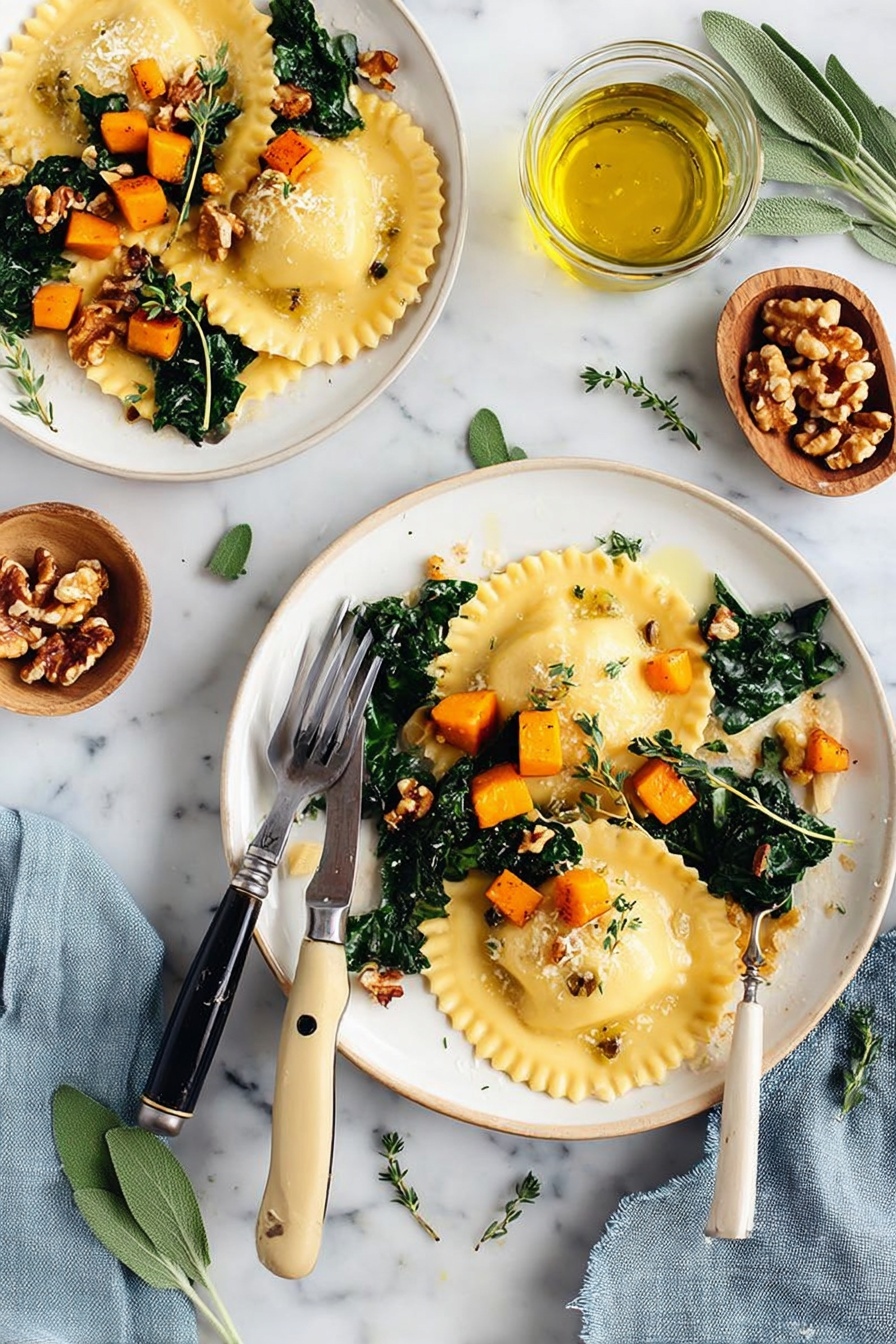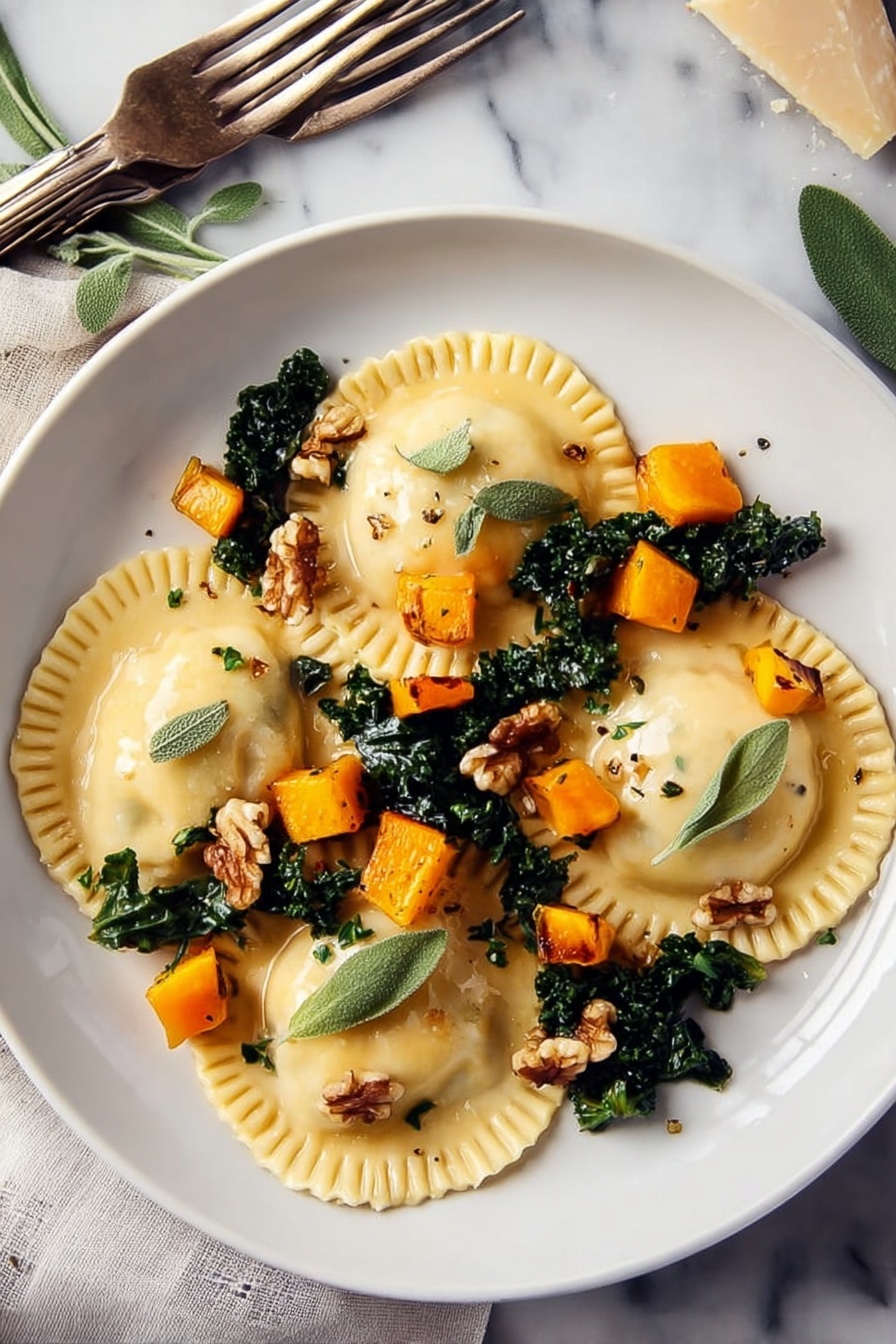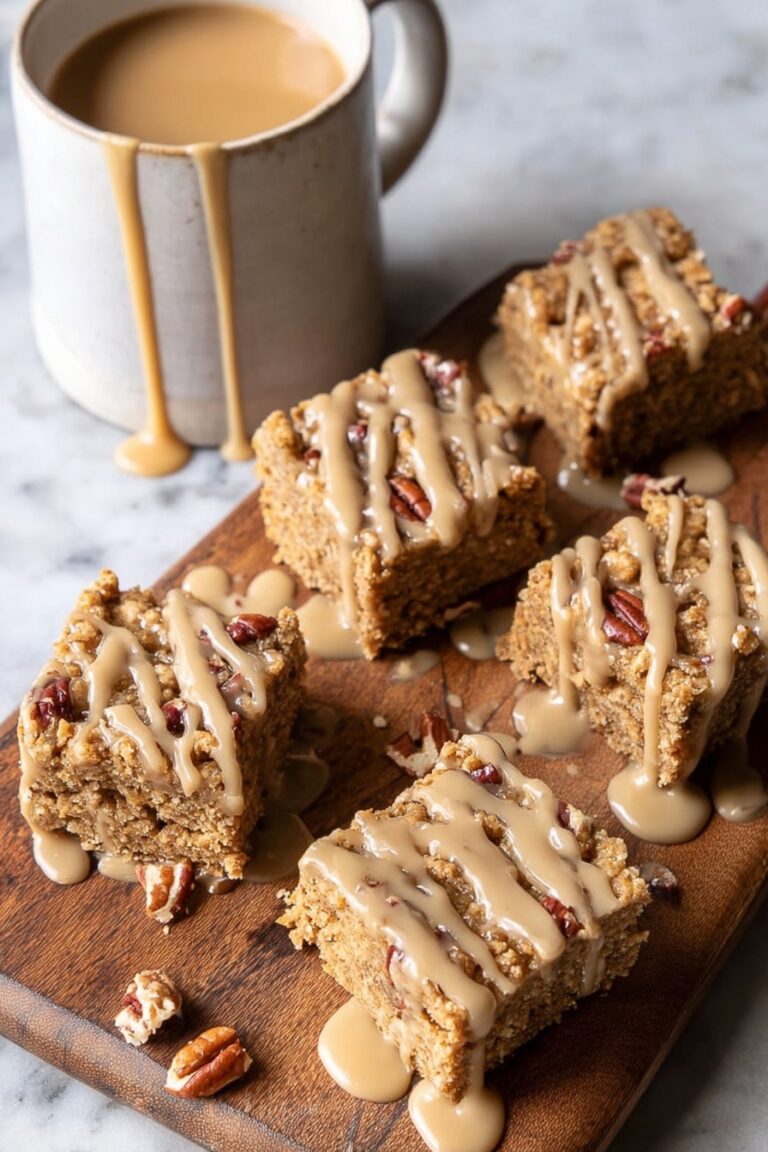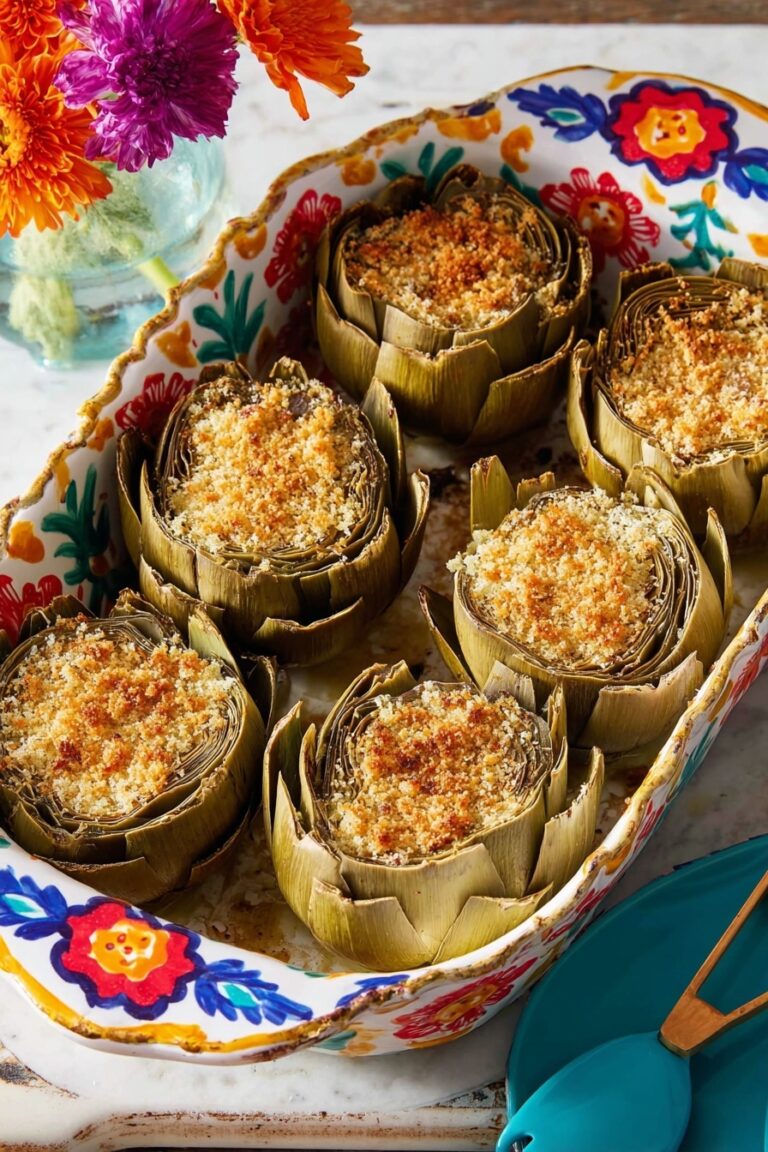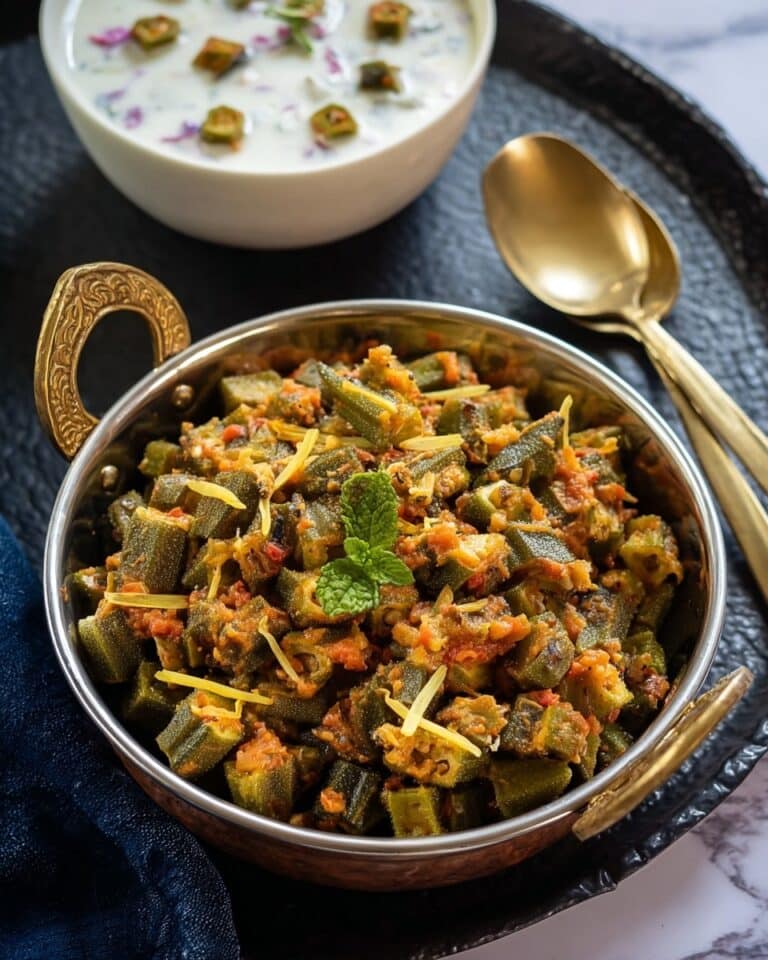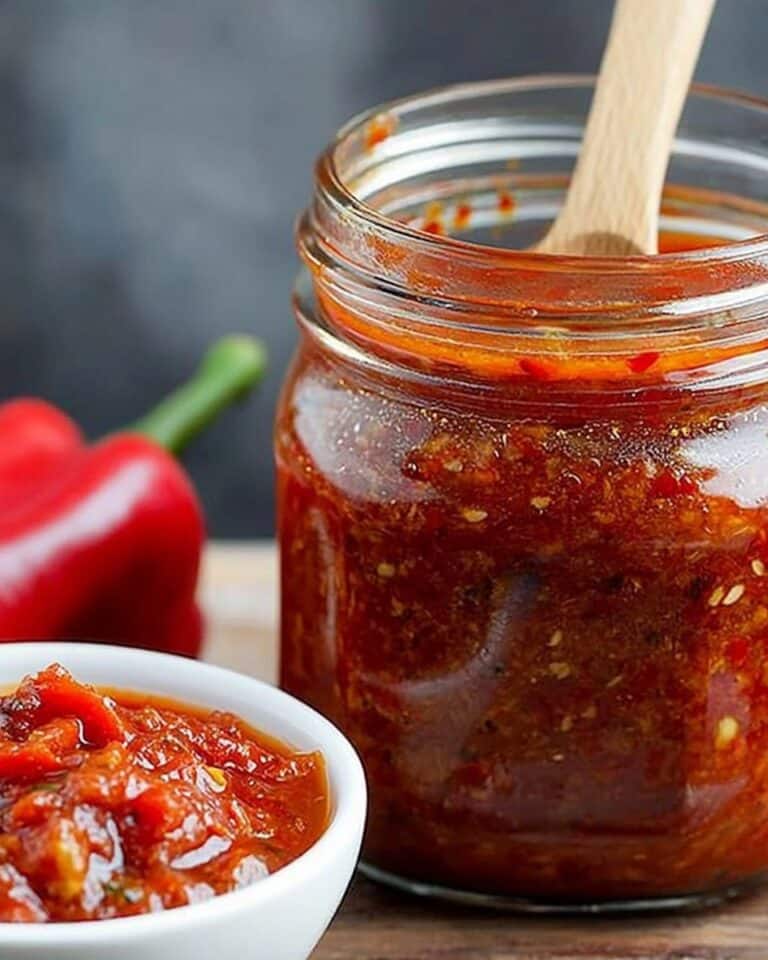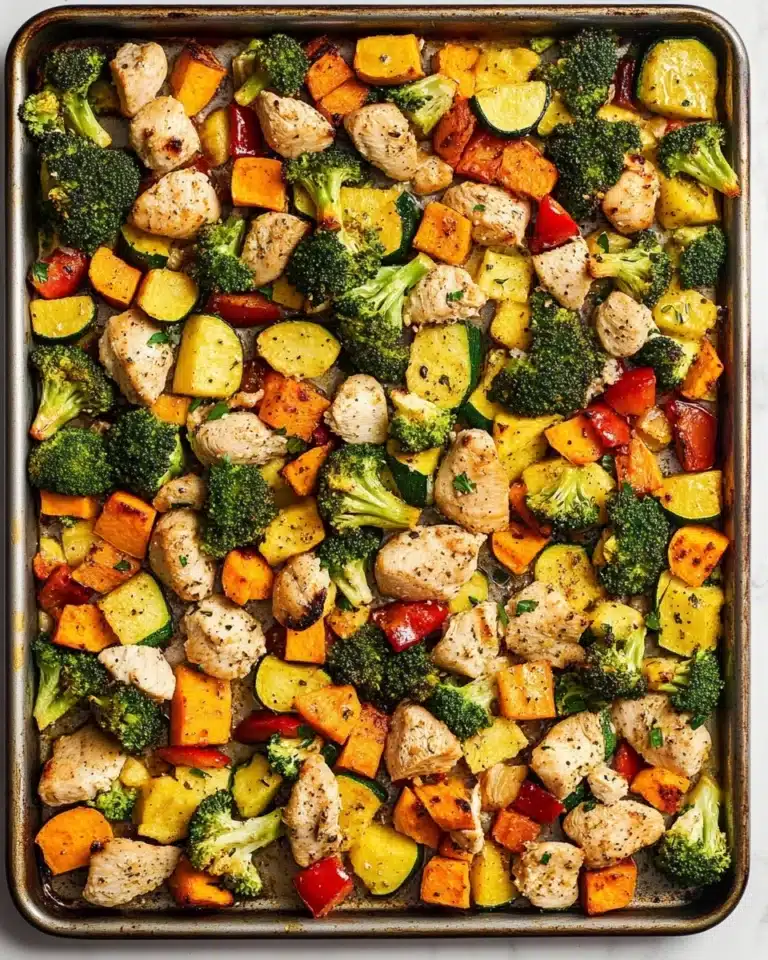If you’re craving a cozy, autumnal meal that feels both fancy and homey, this Butternut Squash Ravioli with Sage-Walnut Filling and White Wine Sage Sauce Recipe is a total winner. I absolutely love how the sweet, nutty filling pairs with the aromatic sage and a light white wine sauce that ties everything together. Trust me, once you try it, you’ll find yourself making this ravioli again and again, especially as the cooler months roll in.
Why You’ll Love This Recipe
- Rich Seasonal Flavors: The natural sweetness of roasted butternut squash perfectly complements the earthy sage and crunchy walnuts.
- Homemade Pasta Freshness: Making your own pasta dough elevates the dish’s texture and flavor—you’ll taste the difference!
- Elegant Yet Approachable: This recipe looks and tastes gourmet but is totally doable in a home kitchen, even if you’re a ravioli rookie.
- Versatile Serving Options: Whether you want to add sautéed kale or a sprinkle of pecorino, you can easily tailor this ravioli to your family’s preferences.
Ingredients You’ll Need
Each ingredient works in harmony here to build layers of flavor, from the sweetness of the butternut squash to the herbal warmth of sage and the crunch of toasted walnuts. Shopping for the freshest herbs and a good quality white wine really pays off in this recipe.
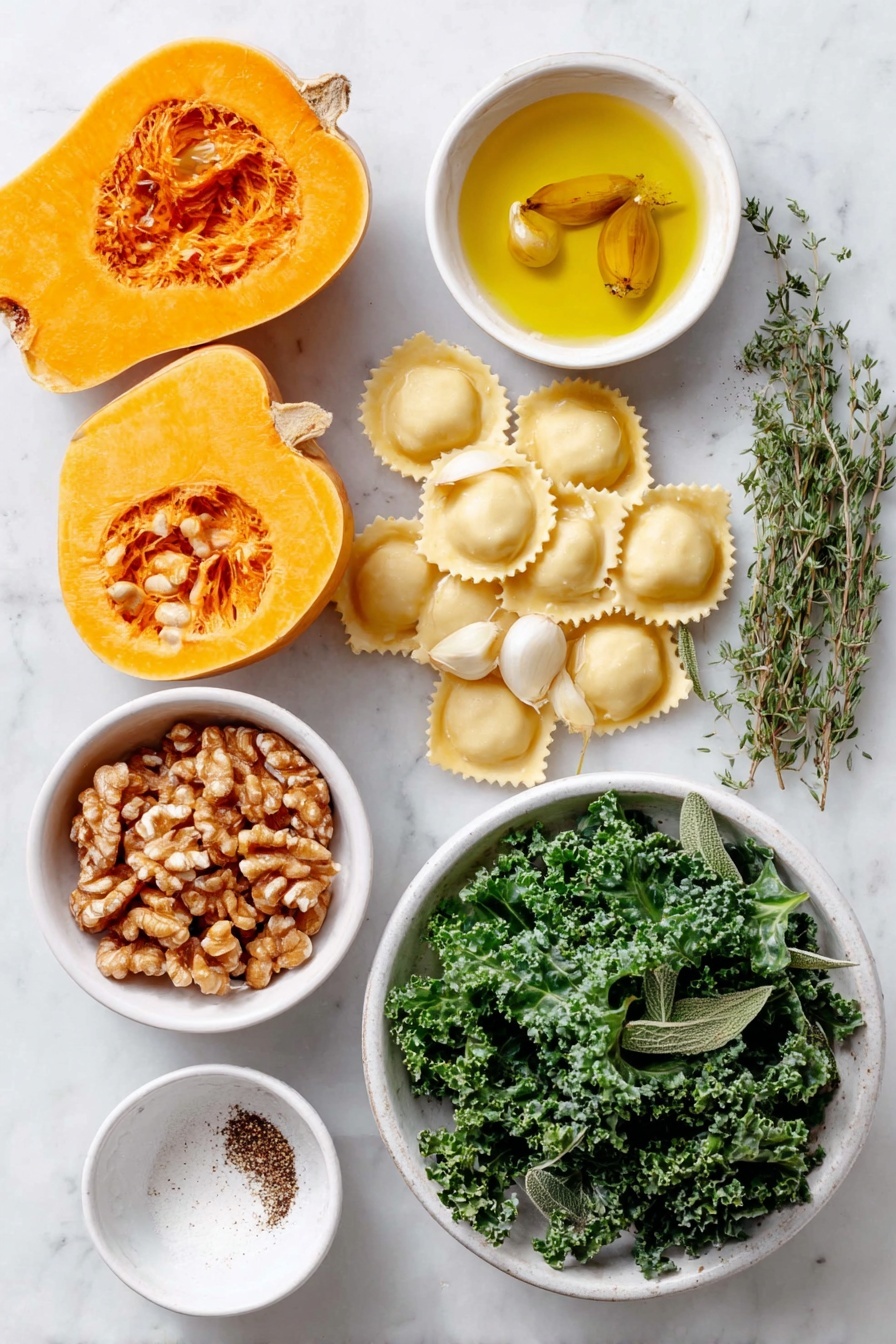
- Butternut squash: Look for a smaller, firm squash for sweeter flesh and easier roasting.
- Extra-virgin olive oil: Use a good-quality oil for drizzling and sauce to maximize flavor.
- Shallot: Adds a mild sweetness; avoid yellow onions as they can be too sharp.
- Garlic cloves: Fresh cloves give the best aromatic punch—avoid pre-minced for this recipe.
- Fresh sage leaves: The star herb here—pick bright, tender leaves for the best taste.
- Homemade pasta dough: Flour, eggs, and a pinch of salt create your foundation; making it fresh makes the ravioli decadent.
- Walnuts: Toast them lightly before chopping—to bring out their nutty richness.
- Apple cider vinegar: Adds brightness and balances the sweet squash filling.
- Nutmeg: Just a pinch gives warmth and depth without overpowering.
- Sea salt and freshly ground black pepper: Essential seasoning throughout the dish.
- Dry white wine: Choose a crisp option like Pinot Grigio or Sauvignon Blanc for the sauce.
- Fresh thyme leaves: Complement the sage perfectly in the white wine sauce.
- Optional ingredients—roasted butternut squash cubes, sautéed kale, grated pecorino cheese: These add texture and flavor for serving but aren’t mandatory if you want to keep it simple.
Variations
I love making this recipe as is, but sometimes I mix things up, especially based on what I have on hand or dietary needs. It’s very forgiving, so don’t hesitate to personalize it!
- Vegan Version: Swap the homemade pasta for vegan dough and omit the pecorino or use a plant-based cheese alternative—I’ve done this and still got rave reviews.
- Add Protein: For a heartier meal, you can stir in some cooked, crumbled sausage into the filling—just be sure to balance the flavors carefully.
- Seasonal Herbs: Try swapping sage for rosemary or thyme depending on your mood; I’ve made this with rosemary once and the earthiness was incredible.
- Alternative Nuts: If walnuts aren’t your favorite, toasted pecans or hazelnuts make great substitutes in the filling for a different crunch.
How to Make Butternut Squash Ravioli with Sage-Walnut Filling and White Wine Sage Sauce Recipe
Step 1: Roast the Squash and Aromatics
Start by preheating your oven to 400°F and lining a baking sheet with parchment paper. Cut the butternut squash in half lengthwise, scoop out the seeds, and drizzle both halves with olive oil; sprinkle with salt and pepper. Place them cut side down on the sheet and prick the skin a few times with a fork—that trick helps it roast evenly without bursting. Roast for about 40 minutes until tender and caramelized on the edges.
Meanwhile, wrap the chopped shallot, garlic cloves, and fresh sage leaves in a piece of foil with a drizzle of olive oil and a pinch of salt and pop this alongside the squash in the oven for 20 minutes. After roasting, let everything cool for at least 30 minutes—this resting time really helps the flavors deepen and makes the filling smooth and creamy.
Step 2: Prepare the Filling
Once cooled, pulse the toasted walnuts in your food processor until finely ground—if you grind them too much, you’ll lose that lovely texture, so just keep it coarse fine. Add the roasted shallot, garlic, and sage, then scoop in about 1½ packed cups of the roasted butternut squash. Toss in the apple cider vinegar, a pinch of nutmeg, sea salt, and several grinds of black pepper. Pulse again until the filling is very smooth and well combined. Pop it in the fridge to chill while you roll out your pasta dough.
Step 3: Roll Out the Pasta and Assemble Ravioli
Once your homemade pasta dough is well rested, roll it out into four large sheets according to your favorite pasta recipe’s instructions. I usually skip folding steps here so I end up with nice even sheets, perfect for filling. Lay two sheets on a floured surface and dollop out the filling using a 1-tablespoon cookie scoop—this helps keep the filling consistent in size. Space them evenly depending on your ravioli stamp size.
Place the remaining two sheets over the filled ones, then gently press around each mound to seal out any air pockets. Use a ravioli stamp or cutter to cut out the shapes. I like to dip my fingers in flour while pressing to avoid sticking. These little pockets of joy are now ready to cook.
Step 4: Cook the Ravioli and Make the Sauce
Bring a large pot of salted water to a boil. Drop in the ravioli in batches, cooking them about 4 minutes—fresh pasta cooks quickly, so keep an eye on them; they’ll float to the top when done. While the ravioli cook, heat 2 tablespoons of olive oil in a medium skillet over medium heat. Add the sliced garlic and sage leaves, cooking gently for about 3 minutes until fragrant and just golden.
Add the white wine, fresh thyme leaves, and ¼ teaspoon sea salt; cook, stirring, for another 2 minutes. The wine reduces slightly, creating a beautiful, delicate sauce that lightly coats the ravioli.
Step 5: Plate and Garnish
Using a slotted spoon, transfer the cooked ravioli to warm plates. Spoon the white wine sage sauce over the top, then sprinkle with chopped walnuts and freshly ground black pepper for some crunch and extra flavor. If you like, add roasted squash cubes, sautéed kale, and grated pecorino cheese to elevate the dish even more. It’s a feast for the senses and looks unbelievably beautiful on the plate.
Pro Tips for Making Butternut Squash Ravioli with Sage-Walnut Filling and White Wine Sage Sauce Recipe
- Even Roasting: Poking holes with a fork in the squash skin helps steam escape, leading to evenly cooked, tender squash every time.
- Chill the Filling: I discovered this trick—chilling the filling firms it up, making it easier to portion and seal without leaks.
- Seal Thoroughly: Press out all air pockets to prevent the ravioli from bursting during cooking; use a bit of water on edges if needed to help them stick.
- Timing Sauce & Pasta: Start cooking the ravioli just as you begin the sauce; this way, everything comes together perfectly hot and fresh.
How to Serve Butternut Squash Ravioli with Sage-Walnut Filling and White Wine Sage Sauce Recipe

Garnishes
I swear by fresh chopped walnuts sprinkled on top—they add a fantastic crunch and earthy note. A dusting of grated pecorino cheese is my go-to for that salty, creamy finish. And those crisp sage leaves in the sauce double as a fun and fragrant garnish that guests love.
Side Dishes
My family goes crazy for sautéed kale with garlic on the side—it adds a healthy green punch and balances the richness. A simple arugula salad with lemon vinaigrette is also a refreshing match. For a heartier meal, crusty garlic bread or roasted root vegetables make great companions.
Creative Ways to Present
For a special dinner, I arrange the ravioli in a circular pattern on a white plate, drizzle the sauce over each piece, and scatter roasted squash cubes artistically around. Adding edible flowers or tiny sage sprigs makes it feel restaurant-worthy—and your guests will be impressed!
Make Ahead and Storage
Storing Leftovers
If you have leftovers (and let’s be honest, you might!), store the cooked ravioli in an airtight container in the fridge for up to 2 days. I like to keep the sauce separate to avoid sogginess—reheat them gently together just before serving.
Freezing
I freeze uncooked ravioli on parchment-lined trays, spaced apart so they don’t stick together. Once frozen solid, I transfer them to freezer bags. This way, you can boil them straight from frozen—just add an extra minute or two to the cooking time for perfect results.
Reheating
To reheat cooked ravioli, I simmer them gently in a little butter or olive oil in a skillet rather than the microwave. This keeps them tender with a slight crisp on the edges. Alternatively, a quick dip in boiling salted water works great if you want to freshen them up before serving.
FAQs
-
Can I use store-bought pasta sheets instead of making my own?
Absolutely! While homemade pasta offers the best texture and flavor, using fresh store-bought pasta sheets can save time and still make a delicious ravioli. Just make sure the sheets are fresh and pliable to seal the filling well.
-
What if I don’t have a ravioli stamp—can I shape ravioli differently?
Yes, you can simply use a sharp knife or a pizza cutter to cut squares, then press the edges with a fork to seal. It might not be as fancy, but your ravioli will taste just as good!
-
How do I prevent the ravioli from leaking during cooking?
Make sure to press out any air pockets around the filling and seal the edges firmly—moistening the dough edges with a little water helps. Also, avoid overfilling the ravioli, which can cause bursting.
-
Can I substitute walnuts with other nuts?
Definitely—pecans or hazelnuts work well as alternatives and add slightly different flavor profiles. Toast them lightly before using for that irresistible nutty aroma.
-
Is there a shortcut if I don’t have time to roast the shallot, garlic, and sage separately?
While roasting enhances the flavor and softens these ingredients perfectly, you can sauté them gently in olive oil until soft. It won’t be quite the same but still delicious if you’re pressed for time.
Final Thoughts
This Butternut Squash Ravioli with Sage-Walnut Filling and White Wine Sage Sauce Recipe is one of those dishes I love sharing because it feels like a hug on a plate—comforting, elegant, and bursting with seasonal flavors. Every time I make it, I’m reminded how approachable gourmet cooking can be when you break it down step-by-step. I can’t wait for you to try this; it’s perfect for impressing friends, enjoying a quiet night in, or celebrating the harvest season. Give it a go—you’ll thank yourself later!
Print
Butternut Squash Ravioli with Sage-Walnut Filling and White Wine Sage Sauce Recipe
- Prep Time: 1 hour
- Cook Time: 1 hour
- Total Time: 2 hours
- Yield: Serves 4
- Category: Main Course
- Method: Baking
- Cuisine: Italian
- Diet: Vegetarian
Description
Delicious homemade Butternut Squash Ravioli featuring a roasted butternut squash filling combined with sage, walnuts, and a hint of apple cider vinegar. Served with a fragrant sage and garlic white wine sauce, this dish pairs the natural sweetness of squash with the earthiness of nuts and herbs for a comforting and elegant meal perfect for fall or winter dinners.
Ingredients
For the ravioli
- 1 small butternut squash
- Extra-virgin olive oil, for drizzling
- 1 medium shallot, roughly chopped (scant ½ cup)
- 3 garlic cloves, peeled
- ¼ cup loose-packed fresh sage leaves
- 1 recipe Homemade Pasta dough
- ⅓ cup chopped walnuts
- 1 teaspoon apple cider vinegar
- Pinch nutmeg
- ¾ teaspoon sea salt, plus more for sprinkling
- Freshly ground black pepper
For serving
- 2 tablespoons extra-virgin olive oil
- 2 garlic cloves, thinly sliced
- 10 fresh sage leaves
- 2 tablespoons dry white wine
- 1 teaspoon fresh thyme leaves
- ¼ teaspoon sea salt
- ¼ cup chopped walnuts
- Freshly ground black pepper
- 1 cup roasted butternut squash cubes (optional)
- ½ bunch sautéed kale (optional)
- Grated pecorino cheese (optional)
Instructions
- Preheat and roast squash: Preheat oven to 400°F (204°C) and line a baking sheet with parchment paper. Cut the butternut squash in half vertically, scoop out seeds, drizzle with olive oil, and sprinkle with salt and pepper. Place cut side down on the baking sheet, prick skin several times with a fork, and roast for 40 minutes until tender.
- Roast shallot, garlic, and sage: Wrap the chopped shallot, peeled garlic cloves, and sage leaves in foil with a drizzle of olive oil and pinch of salt. Place in oven alongside the squash and roast for 20 minutes. Allow all roasted ingredients to cool for at least 30 minutes.
- Prepare pasta dough: Make your homemade pasta dough according to your recipe. Wrap in plastic wrap and let it rest while preparing the filling.
- Make the filling: Pulse walnuts in a food processor until very finely ground. Add roasted shallot, garlic, and sage, then add 1½ packed cups of the roasted butternut squash. Add apple cider vinegar, nutmeg, sea salt, and freshly ground black pepper. Pulse until the mixture is very smooth. Chill until ready to use.
- Roll out pasta sheets: Roll out pasta dough into thin sheets, following your recipe instructions. Spread the pasta sheets on a floured surface. Use a 1-tablespoon cookie scoop to portion the filling onto 2 sheets evenly.
- Form ravioli: Place the remaining two pasta sheets over the filling sheets. Gently press around the filling to seal. Use a ravioli stamp or cutter to cut out individual ravioli shapes.
- Cook ravioli: Bring a large pot of salted water to a boil. Drop the ravioli in and cook for 4 minutes until tender and floating. Drain carefully.
- Make the sauce: In a medium skillet, heat 2 tablespoons olive oil over medium heat. Add sliced garlic and sage leaves and cook for 3 minutes until fragrant. Stir in white wine, fresh thyme, and ¼ teaspoon sea salt. Cook and stir for 2 minutes to reduce slightly.
- Serve: Spoon the sauce over the cooked ravioli. Top with chopped walnuts and freshly ground black pepper. Optionally garnish with roasted butternut squash cubes, sautéed kale, and grated pecorino cheese for extra flavor and texture.
Notes
- Resting the pasta dough after making it allows it to relax and makes rolling easier.
- Make sure the filling is smooth and well-chilled to help the ravioli seal properly.
- If you don’t have a ravioli stamp, you can carefully seal ravioli using a fork.
- The optional roasted squash cubes and sautéed kale add extra texture and nutrients but can be omitted.
- Use freshly ground black pepper to enhance the flavor in both the filling and sauce.
- Serve immediately for best texture and flavor.
Nutrition
- Serving Size: 1 serving (approximately 5-6 ravioli)
- Calories: 420 kcal
- Sugar: 5 g
- Sodium: 420 mg
- Fat: 20 g
- Saturated Fat: 3.5 g
- Unsaturated Fat: 15 g
- Trans Fat: 0 g
- Carbohydrates: 50 g
- Fiber: 6 g
- Protein: 10 g
- Cholesterol: 15 mg

